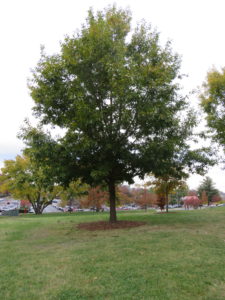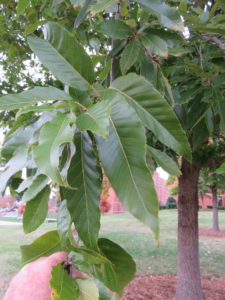Sawtooth oak (Quercus acutissima) is a medium-sized deciduous oak that exhibits traits similar to both the white oak and red oak sections. Indigenous to China, Korea and Japan, sawtooth oak has naturalized in some parts of the U.S. (USDA hardiness zones (5?)6-9). Sawtooth oak grows 40-60 feet tall and wide with broad spreading branches and rounded canopy.
Leaves of sawtooth oak are frequently mistaken for chestnut (Castanea). Long (5 to 7 inches long), lance-shaped, glossy dark green leaves are chestnut-like. Leaf veins are well defined, each ending with a single bristle on the margin (leaf edge). Fall color is variable, ranging from an attractive golden brown to undistinguished pale brown. Dead leaves tend to persist through most of winter.
Long stringy, yellowish-green catkin flowers in separate (male open first) and female catkins appear in early to mid-spring before leaves emerge. Flowers are not ornamentally significant.
Sawtooth oak grows in average well-drained soil and in full sun. Fertilize in late winter with a slow release product such as Osmocote™ or Nutrikote™. The tree tolerates summer heat and humidity. Chlorotic or yellowed leaves is common in neutral to alkaline pH soils in summer. Compared to most oak species, it is moderately pest resistant.
Its corky ridged gray bark matures to a black fissured bark over the years in this long-lived oak. Sawtooth oak this medium to large oak is not planted enough. It is an exceptional shade or specimen tree in residential or park settings and is also found lining parking lots, median strips and roadways.
Acorns are oval in shape and start to form start in 10-12 years after planting. Cap covers nearly two-thirds of nut with hairy scales that are prominently reflexed. Acorns ripen in early fall and are an important wildlife food source.



 Posted in
Posted in 
